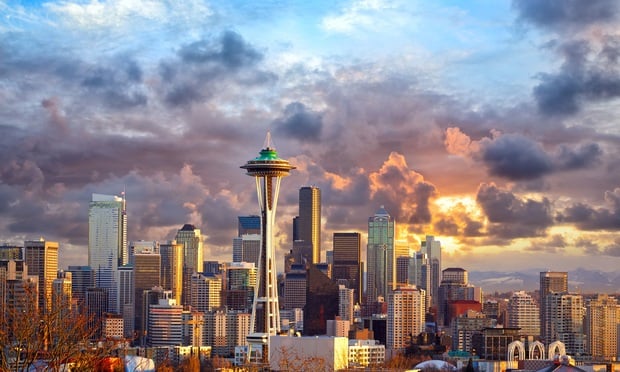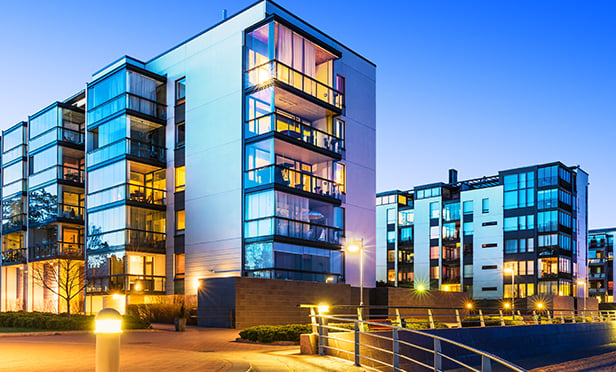 The 273,000-square-foot office building was built in 1914 and is Seattle's oldest highrise (credit: Unico).
The 273,000-square-foot office building was built in 1914 and is Seattle's oldest highrise (credit: Unico).
SEATTLE—Historic Smith Tower has earned a rare LEED Platinum certification from the US Green Building Council/USGBC. Unico Sustainability, a division of Unico Properties, provided the LEED certification services.
The 273,000-square-foot class-A office building was built in 1914 and is the oldest skyscraper in Seattle. The high-rise building with street-level retail was the fourth tallest building in the world when it was completed and it spent nearly 50 years as the tallest building on the West Coast. This prominent tower is protected by both the local and national landmark preservation boards. As such, not only is the exterior facade protected, but many of the interior finishes are protected as well.
Real estate investment and operating firm Unico Properties LLC, a subsidiary of Unico Investment Group LLC, invested significant capital and cosmetic upgrades to the building, which was celebrated in a grand reopening in 2016.
Unico hosted another ceremony this week to celebrate the tower's latest milestone. Kimberly Lewis, USGBC's senior vice president of market transformation, presented the plaque to the Unico team. Building tours were provided after the ceremony.
“It takes effort and leadership to achieve the highest level of LEED certification, especially at a historic and architecturally significant building like Smith Tower,” said Brett Phillips, Unico Properties vice president, sustainable and responsible investments. “Earning LEED Platinum at a building of this vintage and national prominence is a true testament to the efforts of our team. We're pleased to further invest in Smith Tower with our commitment to sustainable stewardship, and we're honored to achieve this milestone that further solidifies the building's reputation as a premier city landmark that offers a superior corporate image for both professional services and creative and technology firms.”
Some of the key highlights achieved at Smith Tower for LEED Platinum certification:
Unico launched a restroom composting program in 2015 in which all the paper towels in the restrooms throughout the building are composted. Garbage containers in the restrooms were converted to compost waste with proper signage and compostable liners, while a secondary garbage container was added under each sink for non-compostable waste.
Unico implemented the EnelX Energy Information System to help reduce energy while increasing net operating income. Since EnelX was installed in 2017, Unico has implemented eight operational efficiency measures resulting in a 15% reduction in energy use during the baseline.
Unico's solid waste management plan aims to recycle at least 50% of all ongoing consumable waste, 100% of all durable goods, 90% of all construction-related waste, and 100% of all mercury-containing lamps and batteries.
Unico implemented a multi-layered preventative maintenance plan to ensure the building is continuously operating at peak performance.
Several energy-saving capital projects were implemented during the last several years including high-efficiency boilers, LED lighting in common areas and exteriors, and an HVAC controls upgrade.
“The primary issue is that as a historic building, the look and feel of the era must be maintained, so fixtures must fit in aesthetically and HVAC work needs to be hidden or camouflaged. There's an extra level of care required,” Phillips tells GlobeSt.com. “Existing pipes and shafts in building limit the amount of work that can be done without major replacements. Plumbing fixtures need to be able to operate under current water pressure/pipe size conditions. Building systems have been installed and augmented in a variety of ways over the past 90 years. It takes much more effort, i.e., forensic analysis, in an old building to untangle layers of fixes and changes, identify what is working well and what is not working as well as it once did, and to determine the best optimization methods.”
In addition, Smith Tower won the BOMA International TOBY Award 2019 for the outstanding building of the year in the historical building category. The TOBY Award is presented to buildings in the commercial real estate industry and recognizes participants for excellence in building management.
“We are honored to receive the prestigious TOBY Award from BOMA International for our commitment to providing our best-in-class building operation, management and service at Smith Tower,” said Lynda Collie, Unico Properties director of real estate services. “It is our priority to provide first class management and operation of Seattle's first skyscraper from the ground floor to the observatory, bringing an exciting and captivating experience to tourists, tenants and visitors at Smith Tower.”
The reality of this structure was more a product of New York than of Seattle, a supremely optimistic gesture by Lyman Cornelius Smith, a Syracuse industrialist, and his son, Burns Lyman Smith. The Smith son first visited Seattle in 1888 and later convinced his father to see the city for himself. L.C. had prospered making shotguns (under his own name and the names of others, although he had no connection to handgun manufacturer Smith & Wesson) and typewriters (L. C. Smith, later Smith-Corona). In the early 1890s, local real estate mogul J.W. Clise visited the elder Smith in Syracuse, and sold him eight separate Pioneer Square properties sight unseen, in what was said to be the largest sale of Seattle property in the city's history up to that point, according to HistoryLink.
Given Smith's lack of development experience and apparent taste for bravado, it's surprising the building was actually completed. The finished building had 33 usable above-ground retail and office floors, plus an observatory level. Where the leading New York skyscrapers were faced in stone, Smith's project was clad in terra cotta. The two most important materials came from outside the region: structural steel from Pennsylvania and terra cotta from California. The owner-developers and the architects were in Syracuse, and the structural engineers and general contractor were based in New York City.
And, Smith Tower opened more than two years after its target date, while lower-floor construction was still going on. Still, the building was a marvel of its time. Its eight high-speed elevators were the finest on the coast and its exotic observatory floor, first announced as a Japanese tea room but built in the style of a Chinese temple interior (albeit with low ceilings), also had no equal in the West.
It's not clear that the building ever turned a profit for the Smiths, who reportedly sold the structure after only 10 years. Altogether, the building has changed hands 12 times, says HistoryLink.
Want to continue reading?
Become a Free ALM Digital Reader.
Once you are an ALM Digital Member, you’ll receive:
- Breaking commercial real estate news and analysis, on-site and via our newsletters and custom alerts
- Educational webcasts, white papers, and ebooks from industry thought leaders
- Critical coverage of the property casualty insurance and financial advisory markets on our other ALM sites, PropertyCasualty360 and ThinkAdvisor
Already have an account? Sign In Now
*May exclude premium content© 2024 ALM Global, LLC, All Rights Reserved. Request academic re-use from www.copyright.com. All other uses, submit a request to [email protected]. For more information visit Asset & Logo Licensing.








